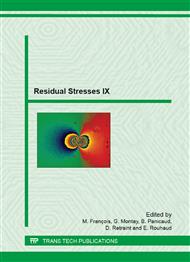p.580
p.586
p.592
p.598
p.603
p.609
p.615
p.622
p.628
Effect of Built-Up Edge Formation on Residual Stresses Induced by Dry Cutting of Normalized Steel
Abstract:
The tool and workpiece surface layer states of the tribosystem uncoated WC-Co cutting tools vs. normalised SAE 1045 workpiece material are studied in detail for a dry metal cutting process. Within the system the cutting parameters (cutting speed, feed rate, cutting depth) determine the wear state of the cutting tool and the resulting surface layer state (residual stress) in the workpiece. As the built-up edge can be used as a possible wear protecting layer [1] the influence of built-up edge and wear behaviour of the cutting tool was examined with respect to the workpiece surface layer state for knowledge based metal cutting processing. Small compressive stresses (-60-80 MPa) are induced in the surface layer, that are nearly homogeneous for the highest built-up edge, which lead to the lowest tool wear in combination with lowest cutting temperature.
Info:
Periodical:
Pages:
603-608
Citation:
Online since:
August 2014
Authors:
Keywords:
Permissions:
Share:
Citation:


